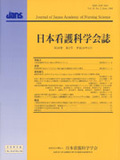Japanese
English
- 販売していません
- Abstract 文献概要
- 参考文献 Reference
- サイト内被引用 Cited by
要旨
目的:広汎子宮全摘術後患者12名と準広汎子宮全摘術後患者10名を対象として,患者が体験する排尿障害の症状とその経過,その症状に対する対処方法を明らかにすることである.
方法:患者に半構成的面接の後,排尿障害の症状とその症状に対する対処方法を各々カテゴリー化した.症状の経過は,症状の内容,頻度,パターンを図示した.
結果・考察:尿意に関する症状として『尿意の欠如』『尿意の鈍麻』『尿意に代わる感覚』,尿排出に関する症状として『排尿困難』『遷延性排尿』『尿線途絶』『苒延性排尿』『残尿』,およびその他の症状に分類された.尿意および尿排出に関する症状は時間経過とともに軽減したが,広汎子宮全摘術後は準広汎子宮全摘術後と比較して自然排尿確立後もこれらの症状が継続している者が多かった.患者は【排尿のタイミングをとる】【排尿時に腹圧をかける】等の対処方法を用いていたが,なかには合併症を招く可能性のあるような注意を要する対処方法もみられた.
結論:排尿障害に対する現在の看護介入は自然排尿の確立が重視されているが,自然排尿が確立したとしても,広汎子宮全摘術後患者に対してはより適切かつ具体的な指導の検討の必要性および長期間における継続的な看護介入の必要性が示唆された.
Abstract
Aim:This study identified the presence and duration of postoperative urinary symptoms, as well as the coping strategies used to deal with these symptoms using a sample of12postoperative patients with radical hysterectomy and 10postoperative patients with modified radical hysterectomy.
Method:A semi-structured interview was conducted with each patient, and interview data were used to categorize postoperative urinary symptoms and coping strategies. The duration of these symptoms was demonstrated with reference to the contents, frequency, and pattern of these symptoms.
Results:The urinary symptoms experienced by the patients were classified into three types: urge to micturate (e.g., lack of or insensitivity to the urge to urinate or physical sensations, such as bladder distention);urination (e.g., dysuria, difficulty starting, stopping the stream, prolonged urination, or residual urine);and others. The symptoms related to the urge to micturate and urination passed with time. However, the symptoms for patients with radical hysterectomy persisted longer than those for patients with modified radical hysterectomy even after normal urinary patterns were reestablished. Coping strategies such as scheduling time to urinate and applying abdominal pressure when urinating were used;however some strategies required caution because of the potential for complications.
Conclusions:Although the standard of care was to assist all patients with urinary symptoms to reestablish normal urinary patterns, the results suggested that postoperative patients with radical hysterectomy would need adequate, specific, and ongoing nursing interventions even after normal urinary patterns were reestablished.
Copyright © 2008, Japan Academy of Nursing Science. All rights reserved.


